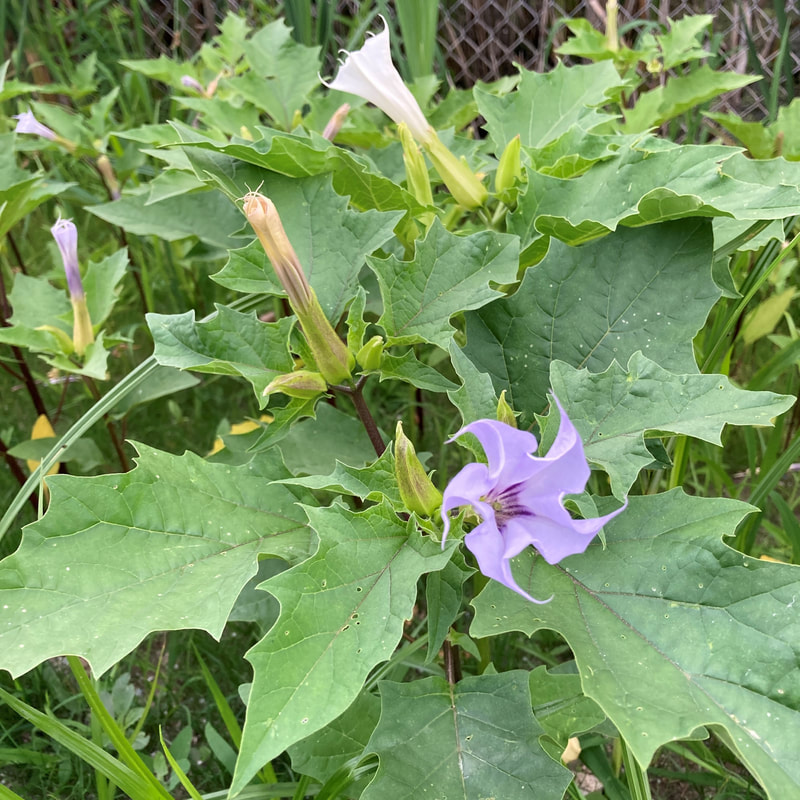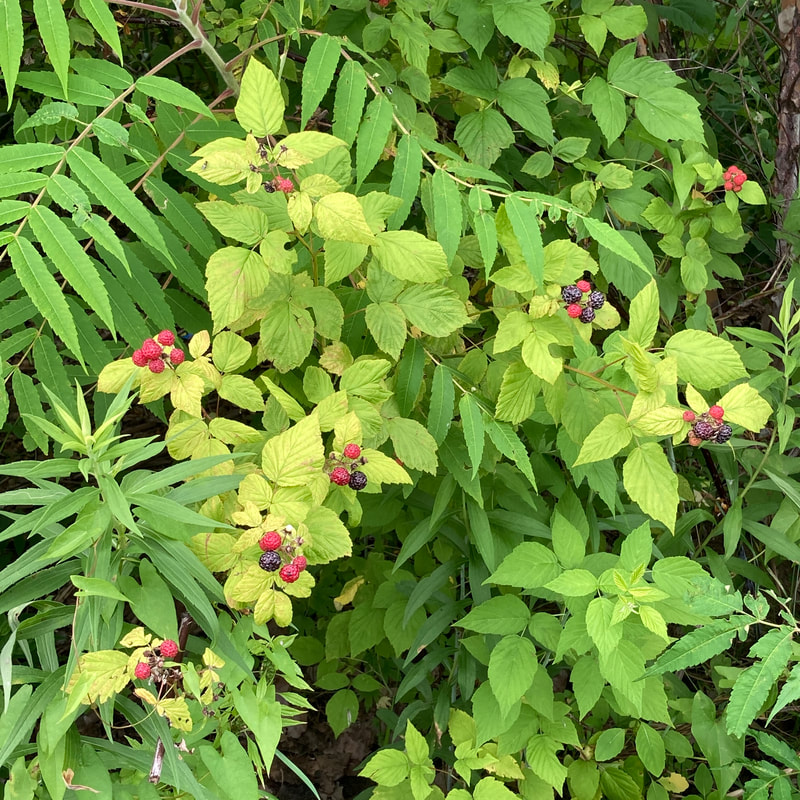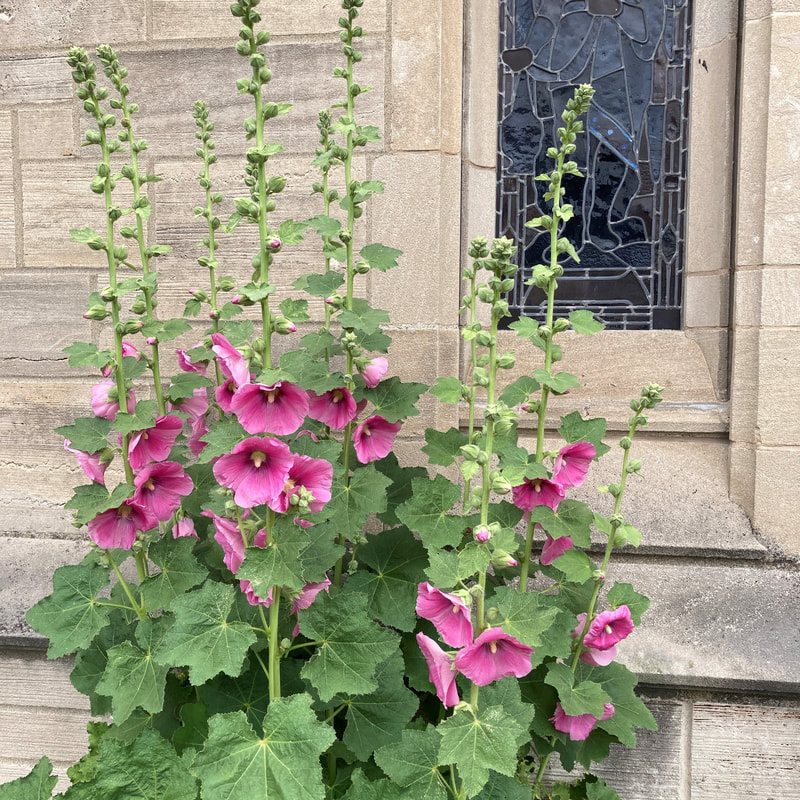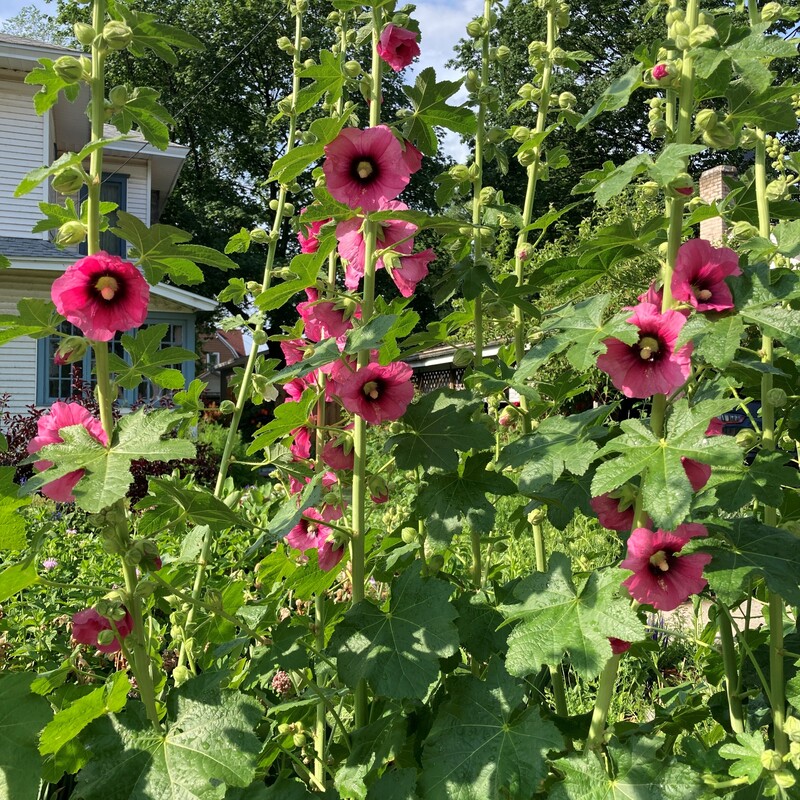|
Photo and article by Donna Iverson Poisonous, mind-altering, and hallucinogenic are some of the words used to describe the native plant, Datura. Commonly known as jimsonweed, it has naturalized in the Muskegon River Basin especially in wetlands. It was there I found it growing along the Lakeshore Bike Trail which runs from Muskegon to Hart. I might have kept riding, except for a recently-published book I was reading by Michael Pollan, entitled This is Your Mind on Plants. In the first section of the book, Pollan describes growing poppy flowers in his garden and a particular poppy, Papaver somniferum. According to Pollan, the seeds of this poppy can be used to make opium tea. It is legal to grow the poppy plant as long as your intention is just to enjoy its decorative qualities. But if your intention is to make homemade opium from the seeds, that is a serious drug felony. Turns out, Datura has a lot in common with the opium poppy. It’s seeds are also hallucinogenic and mind-altering. But it is not classified as an illegal drug although it is a very dangerous plant. Native Americans used it in sacred ceremonies but warned its tribal members: “eat too much and don’t wake up.” Frankly although I found both plants fascinatingly beautiful, I wasn’t about to try growing either one of them. As for the opium poppies, I didn’t want to risk tangling with the FBI. As for Datura, I didn’t want to risk a fatal dose. Ironically, even though Datura was used medicinally in our colonial past to treat pain and fever and induce sleep, today only it’s alkaloids are approved by the FDA. These include atropine, scopolamine, and hyoscyamine. A member of the nightshade family, Datura has acquired many names over the years: moonflower (because it opens and closes at night), locoweed, Mad Hatter, zombie cucumber and Hell’s Bells. Gene Autry sang about it in his signature song “Back in the Saddle Again,” when he crooned, “I’m back in the saddle again where the longhorn feed on the lonely jimsonweed.” In 1676, British soldiers in Jamestown reportedly feasted on boiled salad made from the plant turning them into “natural fools.” It took almost two weeks for them to recover. Afterwards, they remembered nothing of the incident, history books report. In 1971, the author Hunter Thompson mentioned jimsonweed in his book Fear and Loathing in Las Vegas. And Georgia O’Keefe often painted the plant, which grew wild around her New Mexico home. In 2014, one of her jimsonweed paintings sold for $44 million.
1 Comment
Photo and article by Donna Iverson
On a recent bike ride along the Lakeshore Trail, I spied a large bush of black raspberries. It was the first wild black raspberry bush I had seen in many a year. There were only a few ripe black berries to pick but I considered it a major treat anyway. They are tastier than their red raspberry cousins. No doubt about that. Black raspberries are not easy to come by. They aren’t usually available at farmers markets or grocery stores, because they are not easy to ship. And not many people grow them in their gardens. Once home and having savored them, I checked online to see if black raspberry plants were available at local nurseries. None were found although if I’m wrong, I hope someone will point me in the right direction. The plants can be ordered and shipped from out-of-state nurseries, however. Wild black raspberries (Rubus occidentalis) have a short growing season. Native to North America, they are often found in waste areas along streams, like the one I discovered near Beidler Creek adjacent to Heritage Landing on Muskegon Lake. If you are foraging, there are no poisonous lookalikes to worry about. The only berry they might be confused with are blackberries, and both are safe to eat when you find them. While the two berries are related, they are from different horticultural families, with black raspberries belonging to the rose family. The name raspberry harks back to the Old English word, rasp, which translates as rough berry. Although it also may have been derived from the German word raspoie, meaning thicket or from raspise, meaning rose wine. Other names for the plant include scotch cap, black cap and bear’s eye raspberry. The inky-black color comes from the chemical Anthocyanin which is believed to strengthen blood vessels. Native to our area, black raspberries also contain polyphenols, and high levels of Vitamin C. If you do decide to grow them in your yard or garden, they can reach 10 feet tall with 6 foot long stems. They need watering and annual pruning and are susceptible to disease. In the fall, when the berries are gone, the leaves will turn a glowing red. Deer will eat them. They are also invasive. But who cares ?? Photos and article by Donna Iverson Hollyhocks (Alcea rosea) are an old fashioned flower that haven’t lost their appeal. Can you walk by a stand of hollyhocks and not stop and stare? I can’t. In whatever garden or yard they are grown, they tower over the other flowers in summer. Only sunflowers can compete, and then not until August. Hollyhocks, which are members of the Mallow family, evoke visions of old cottage gardens and maybe memories of Beatrix Potter’s book illustrations of Mr. McGregor’s garden in the Peter Rabbit adventures. Hollyhocks are easily grown from seeds in the spring and may flower the first year but may not, as they are biennial. While staking isn’t necessary, they do better grown along a fence or wall for protection from gusty winds. They are short lived, lasting only two or three years but readily self-seed. Hollyhocks can grow as high as nine feet tall and prefer a sunny location in moist rich ground. Water from below so as not to damage the tender blossoms which come in multiple colors including pink, white, violet, red and black. Unfortunately they are susceptible to a lot of pests, including leaf mites, beetles, slugs and powdery mildew. On the plus side, they attract beeswax, butterflies, and hummingbirds. In herbal medicine, hollyhocks are a laxative and an emollient. In olden days, they were used to treat inflammation, bleeding gums, sore throats and bed wetting. They are non toxic to people and animals although leaves and stems may cause rashes on sensitive skin. Hibiscus flowers are also edible. They were often found in the kitchen gardens of colonial New England. The colonists made Hibiscus tea from the flowers. There is a black flower variety called Nigra which is an heirloom plant once grown in the Monticello gardens of Thomas Jefferson. It is four hundred years old and is still a favorite of gardeners and botanists. While there is one Hollyhock native to the Americas, the common variety grown in this country is native to China. It was discovered there in the 1400s by an Englishman named William Turner, who wrote the first Herbal book. He called it “Holyoke” |
Archives
July 2024
Categories |




 RSS Feed
RSS Feed